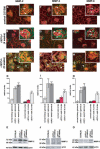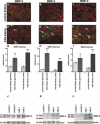Stage-specific action of matrix metalloproteinases influences progressive hereditary kidney disease
- PMID: 16509766
- PMCID: PMC1391977
- DOI: 10.1371/journal.pmed.0030100
Stage-specific action of matrix metalloproteinases influences progressive hereditary kidney disease
Abstract
Background: Glomerular basement membrane (GBM), a key component of the blood-filtration apparatus in the in the kidney, is formed through assembly of type IV collagen with laminins, nidogen, and sulfated proteoglycans. Mutations or deletions involving alpha3(IV), alpha4(IV), or alpha5(IV) chains of type IV collagen in the GBM have been identified as the cause for Alport syndrome in humans, a progressive hereditary kidney disease associated with deafness. The pathological mechanisms by which such mutations lead to eventual kidney failure are not completely understood.
Methods and findings: We showed that increased susceptibility of defective human Alport GBM to proteolytic degradation is mediated by three different matrix metalloproteinases (MMPs)--MMP-2, MMP-3, and MMP-9--which influence the progression of renal dysfunction in alpha3(IV)-/- mice, a model for human Alport syndrome. Genetic ablation of either MMP-2 or MMP-9, or both MMP-2 and MMP-9, led to compensatory up-regulation of other MMPs in the kidney glomerulus. Pharmacological ablation of enzymatic activity associated with multiple GBM-degrading MMPs, before the onset of proteinuria or GBM structural defects in the alpha3(IV)-/- mice, led to significant attenuation in disease progression associated with delayed proteinuria and marked extension in survival. In contrast, inhibition of MMPs after induction of proteinuria led to acceleration of disease associated with extensive interstitial fibrosis and early death of alpha3(IV)-/- mice.
Conclusions: These results suggest that preserving GBM/extracellular matrix integrity before the onset of proteinuria leads to significant disease protection, but if this window of opportunity is lost, MMP-inhibition at the later stages of Alport disease leads to accelerated glomerular and interstitial fibrosis. Our findings identify a crucial dual role for MMPs in the progression of Alport disease in alpha3(IV)-/- mice, with an early pathogenic function and a later protective action. Hence, we propose possible use of MMP-inhibitors as disease-preventive drugs for patients with Alport syndrome with identified genetic defects, before the onset of proteinuria.
Conflict of interest statement
Figures






Similar articles
-
Increased expression of MMP-2, MMP-9 (type IV collagenases/gelatinases), and MT1-MMP in canine X-linked Alport syndrome (XLAS).Kidney Int. 2003 May;63(5):1736-48. doi: 10.1046/j.1523-1755.2003.00939.x. Kidney Int. 2003. PMID: 12675849
-
Laminin compensation in collagen alpha3(IV) knockout (Alport) glomeruli contributes to permeability defects.J Am Soc Nephrol. 2007 Sep;18(9):2465-72. doi: 10.1681/ASN.2007030328. Epub 2007 Aug 15. J Am Soc Nephrol. 2007. PMID: 17699809
-
Laminin-1 reexpression in Alport mouse glomerular basement membranes.Kidney Int. 2003 Mar;63(3):826-34. doi: 10.1046/j.1523-1755.2003.00800.x. Kidney Int. 2003. PMID: 12631063
-
An update on the pathomechanisms and future therapies of Alport syndrome.Pediatr Nephrol. 2013 Jul;28(7):1025-36. doi: 10.1007/s00467-012-2272-z. Epub 2012 Aug 18. Pediatr Nephrol. 2013. PMID: 22903660 Review.
-
Collagen IV diseases: A focus on the glomerular basement membrane in Alport syndrome.Matrix Biol. 2017 Jan;57-58:45-54. doi: 10.1016/j.matbio.2016.08.005. Epub 2016 Aug 27. Matrix Biol. 2017. PMID: 27576055 Free PMC article. Review.
Cited by
-
COL4A4 gene study of a European population: description of new mutations causing autosomal dominant Alport syndrome.Int J Mol Epidemiol Genet. 2014 Dec 15;5(4):177-84. eCollection 2014. Int J Mol Epidemiol Genet. 2014. PMID: 25755845 Free PMC article.
-
Loss of the BMP antagonist USAG-1 ameliorates disease in a mouse model of the progressive hereditary kidney disease Alport syndrome.J Clin Invest. 2010 Mar;120(3):768-77. doi: 10.1172/JCI39569. Epub 2010 Feb 8. J Clin Invest. 2010. PMID: 20197625 Free PMC article.
-
Alport syndrome: its effects on the glomerular filtration barrier and implications for future treatment.J Physiol. 2014 Sep 15;592(18):4013-23. doi: 10.1113/jphysiol.2014.274449. Epub 2014 Aug 8. J Physiol. 2014. PMID: 25107927 Free PMC article. Review.
-
Establishment and comparison of different procedures for modeling intrauterine adhesion in rats: A preliminary study.Heliyon. 2024 Jan 29;10(3):e25365. doi: 10.1016/j.heliyon.2024.e25365. eCollection 2024 Feb 15. Heliyon. 2024. PMID: 38322868 Free PMC article.
-
Upregulated expression of integrin α1 in mesangial cells and integrin α3 and vimentin in podocytes of Col4a3-null (Alport) mice.PLoS One. 2012;7(12):e50745. doi: 10.1371/journal.pone.0050745. Epub 2012 Dec 7. PLoS One. 2012. PMID: 23236390 Free PMC article.
References
-
- Kalluri R. Basement membranes: Structure, assembly and role in tumour angiogenesis. Nat Rev Cancer. 2003;3:422–433. - PubMed
-
- Timpl R. Structure and biological activity of basement membrane proteins. Eur J Biochem. 1989;180:487–502. - PubMed
-
- Yurchenco PD. Assembly of basement membranes. Ann N Y Acad Sci. 1990;580:195–213. - PubMed
-
- Timpl R, Wiedemann H, van Delden V, Furthmayr H, Kuhn K. A network model for the organization of type IV collagen molecules in basement membranes. Eur J Biochem. 1981;120:203–211. - PubMed
-
- Longo I, Porcedda P, Mari F, Giachino D, Meloni I, et al. COL4A3/COL4A4 mutations: From familial hematuria to autosomal-dominant or recessive Alport syndrome. Kidney Int. 2002;61:1947–1956. - PubMed
Publication types
MeSH terms
Substances
Grants and funding
LinkOut - more resources
Full Text Sources
Other Literature Sources
Molecular Biology Databases
Miscellaneous

